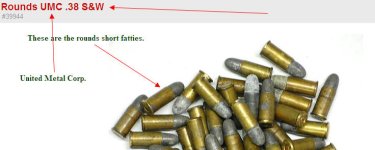No worries. If we see a photo of the gun, it'll be easy to tell a Det. Spcl. from a Model 10, also called the Military and Police.
S&W assigned model numbers beginning in 1957.
But you can easily tell if it's a Det. Spcl. by looking at the gun. It'll say Colt Detective Special on it. And Colts didn't have the front lock for the extractor under the barrel as Smiths do, other than very early M&P's from about 1899-1902.
Many guns have been chambered for .38 S&W, beginning with that company's own, from the 1870's-on. Many were cheap break-top items from H&R, Iver Johnson and some junk guns called Suicide Specials, as they were cheap and some bought them to use just one time.

In 1927, the British military adopted the caliber, loaded with a 200 grain lead bullet. Some "genius" told them that the load would stop men as well as ther .455. The main goal was to get a lighter gun that recoiled less, as few men in wartime would be trained well enough to handle recoil well in a handgun.
They adopted the Enfield No. 2 and issue had begun by 1930 or so. But wartime needs forced the UK to obtain many guns from Colt, Webley, and S&W.
Colt used the cartridge under another name, I think Colt New Police or .38 Short Colt. I'd have to look it up. Chambering was in the Police Positive, not to be confused with the Police Positive Special, which has a longer frame and was usually chambered in .38 Special. However, later Police Positive Specials have been made for the shorter ctg., probably for sales in Commonwealth countries.
The Banker's Special was another Colt in this chambering.
THe Detective Special is just a PPS with a two or three inch bbl. After 1932, it had a rounded butt. Intro. was in 1926.
That's all I have time for. I suggest that you obtain copies of some basic gun books. The best is probably Geoffrey Boothroyd's, "The Handgun", Crown Publishers, 1970. Elmer Keith's, "Sixguns" will also be of great help. Try to get the Revised edition of 1961, as it has info on newer guns, inc. the .44 Magnum.

